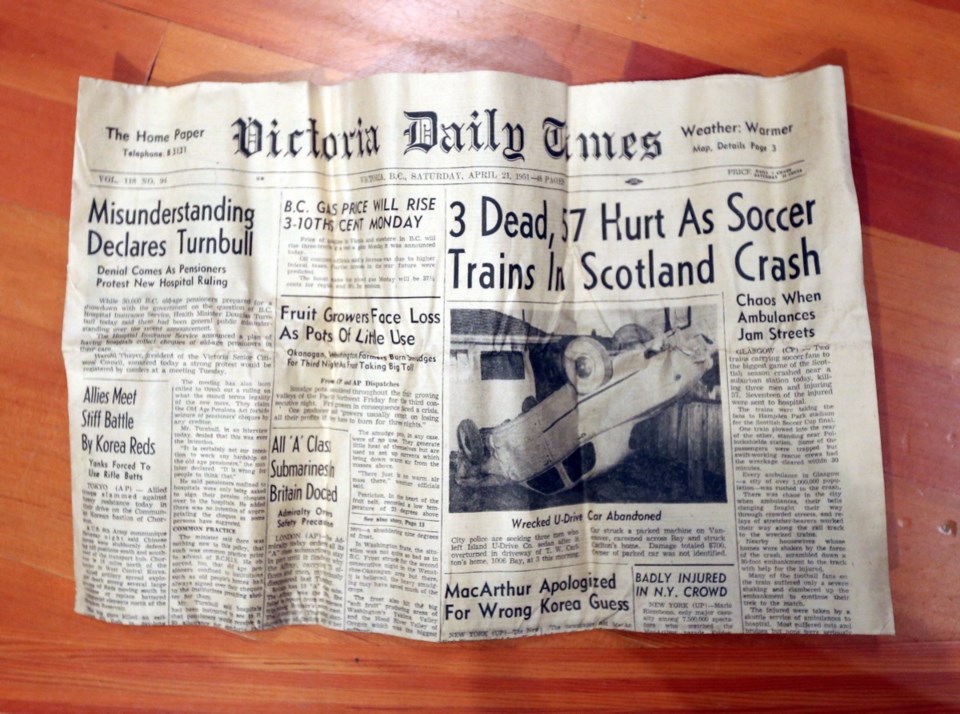Construction workers renovating the front of St. George’s Anglican Church in Cadboro Bay have discovered a treasure behind the building’s cornerstone.
“It appeared to be a time capsule,” said Rev. Richard LeSueur.
The glass bottle contained the April 21, 1951, front page of the Victoria Daily Times (now the Times Colonist), two church bulletins from April 23, the day the cornerstone was laid, and an assortment of coins.
LeSueur said the time capsule gives a small glimpse into church life and Victoria 65 years ago.
“They sang God Save the King and the lieutenant-governor was present at the sod turning — which showed the intermingling of government and church,” he said. “Cadboro Bay at that time would’ve been a cottage community of Victoria.”
LeSueur said he finds it fascinating to think of church members back then placing the time capsule with no idea of who would find it or when.
This is the first major construction at the church since it was built in 1951. The $1.2-million addition will create a new welcoming and multi-use space, washrooms, a kitchenette and seismic upgrades. It is slated to be completed in the summer.
“Now we’re debating what to do when we put back the cornerstone,” said LeSueur, adding they will replace the time capsule with something from this time period. “The kids will be involved in what to put in for the future.”
Time capsules are not uncommon in Victoria, according to Ken Johnson, president of the Victoria Hallmark Society.
“It’s an old tradition to put something under a cornerstone. Almost all major buildings have them,” Johnson said.
John Lutz, a history professor at the University of Victoria, said time capsules were common in the early days of Victoria when Freemasons were the stoneworkers in town.
Cornerstones were often the first stone and reference point for a building. Many were inscribed with the name and date of the building, and some were laid separately as dedication signs.
“Time capsules were part of their ritual,” Lutz said. “I think of them as a message for the future, a hopeful sign the building will last beyond lifetimes.”
A few years ago, a group of his students put together a website documenting several of the buildings in Victoria with time capsules. They include everything from churches and government buildings to the YMCA.
“It’s surprising how common the items are,” said Lutz. The majority of the time capsules contain a newspaper from that day in history, documents from the organization, coins and other historical items.
The 1871 tin box time capsule laid at St. Ann’s Convent School is said to contain these items and relics from the clergy but the location is a mystery.
Two time capsules were laid at the Congregation Emanu-El Synagogue in 1863, one by a member of the congregation and one by the local Masonic fraternity.
In 1879, a cornerstone with a time capsule containing fraternity documents, medals, a newspaper and coins was laid at the new Odd Fellows Hall on Yates and Douglas in an elaborate ritual. The old hall on Wharf Street had burned down.
A copper time capsule was placed under the cornerstone of Royal Jubilee Hospital on April 23, 1889, by the lieutenant-governor’s wife. It contained silver coins, the original plans of the building and newspapers, among other items.
In 2006, St. Michaels University School unearthed a time capsule laid behind the foundation stone of the original schoolhouse in 1908.
The copper box contained the school records, coat of arms and a collection of stamps. The items were placed on display at the school to celebrate its 100th anniversary and are still on display in the archives.



